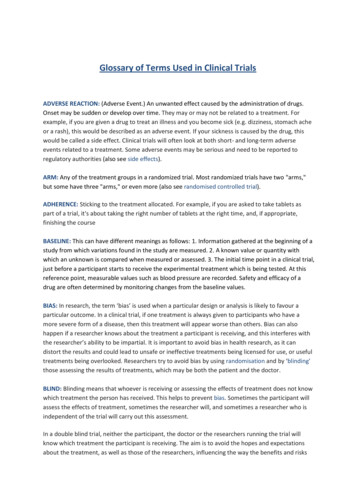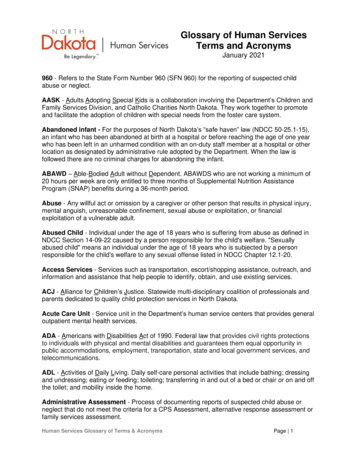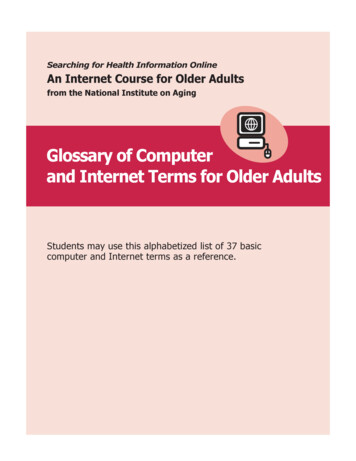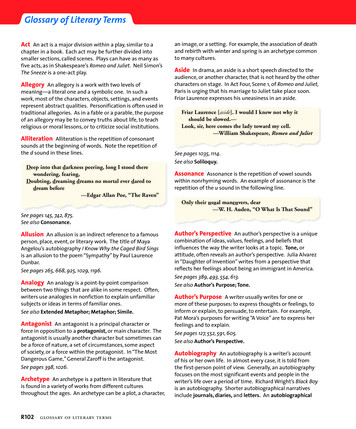
Transcription
Glossary of Terms Used in Clinical TrialsADVERSE REACTION: (Adverse Event.) An unwanted effect caused by the administration of drugs.Onset may be sudden or develop over time. They may or may not be related to a treatment. Forexample, if you are given a drug to treat an illness and you become sick (e.g. dizziness, stomach acheor a rash), this would be described as an adverse event. If your sickness is caused by the drug, thiswould be called a side effect. Clinical trials will often look at both short- and long-term adverseevents related to a treatment. Some adverse events may be serious and need to be reported toregulatory authorities (also see side effects).ARM: Any of the treatment groups in a randomized trial. Most randomized trials have two "arms,"but some have three "arms," or even more (also see randomised controlled trial).ADHERENCE: Sticking to the treatment allocated. For example, if you are asked to take tablets aspart of a trial, it's about taking the right number of tablets at the right time, and, if appropriate,finishing the courseBASELINE: This can have different meanings as follows: 1. Information gathered at the beginning of astudy from which variations found in the study are measured. 2. A known value or quantity withwhich an unknown is compared when measured or assessed. 3. The initial time point in a clinical trial,just before a participant starts to receive the experimental treatment which is being tested. At thisreference point, measurable values such as blood pressure are recorded. Safety and efficacy of adrug are often determined by monitoring changes from the baseline values.BIAS: In research, the term ‘bias’ is used when a particular design or analysis is likely to favour aparticular outcome. In a clinical trial, if one treatment is always given to participants who have amore severe form of a disease, then this treatment will appear worse than others. Bias can alsohappen if a researcher knows about the treatment a participant is receiving, and this interferes withthe researcher’s ability to be impartial. It is important to avoid bias in health research, as it candistort the results and could lead to unsafe or ineffective treatments being licensed for use, or usefultreatments being overlooked. Researchers try to avoid bias by using randomisation and by ‘blinding’those assessing the results of treatments, which may be both the patient and the doctor.BLIND: Blinding means that whoever is receiving or assessing the effects of treatment does not knowwhich treatment the person has received. This helps to prevent bias. Sometimes the participant willassess the effects of treatment, sometimes the researcher will, and sometimes a researcher who isindependent of the trial will carry out this assessment.In a double blind trial, neither the participant, the doctor or the researchers running the trial willknow which treatment the participant is receiving. The aim is to avoid the hopes and expectationsabout the treatment, as well as those of the researchers, influencing the way the benefits and risks
are assessed. It is not always possible to avoid researchers, doctors and participants knowing whichtreatment they are having. For example, the trial may be comparing surgery with no surgery. If theresearcher knows which treatment a participant is receiving, it may be necessary for an independentresearcher, who has not been involved in conducting the trial, to assess the impact of the differenttreatments. (See also single blinded and double blinded).CLINICAL : Founded on observation and treatment of participants, as distinguished from theoreticalor basic science.CLINICAL INVESTIGATOR: A medical researcher in charge of carrying out a clinical trial's protocol.CLINICAL TRIAL: Clinical trials are research studies involving participants that compare a new ordifferent type of treatment with the best treatment currently available. They test whether the newor different treatment is safe and effective by comparing it to what already exists. No matter howpromising a new treatment may appear during tests in a laboratory, it must go through clinical trialsbefore its benefits and risks can really be known. This also applies to many different forms oftreatment, such as surgery, radiotherapy, physical and behavioural interventions, not just drugs. Ifthere is no standard treatment, the new treatment is usually compared with no treatment or with a‘dummy’ treatment (or placebo).Carefully conducted clinical trials are the fastest and safest way to find treatments that work inpeople. Trials are in four phases: Phase I tests a new drug or treatment in a small group; Phase IIexpands the study to a larger group of people; Phase III expands the study to an even larger group ofpeople; and Phase IV takes place after the drug or treatment has been licensed and marketed.COHORT: In epidemiology, a group of individuals with some characteristics in common.CONTRAINDICATION: A specific circumstance when the use of certain treatments could be harmful.CONTROL GROUP: The standard by which experimental observations are evaluated. In many clinicaltrials, one group of patients will be given an experimental drug or treatment, while the control groupis given either a standard treatment for the illness or a placebo (See also placebo and standardtreatment).CROSS OVER TRIALS: A study with treatment changing partway through the trial. For example, if atrial is comparing the effectiveness of 2 different sorts of exercise, you might take part in exercise Afor the first part of the trial and then exercise B for the second, then perhaps back to A again – andso on. You cross over from one treatment group to the other, and comparisons are then madebetween how well you felt during the different periods.DATA SAFETY AND MONITORING COMMITTEE: Most trials have an independent data monitoringcommittee that follows the progress of the trial and makes sure it is being run properly. The peopleon the data monitoring committee are experts in clinical trials, statistics or in the disease beingstudied. They are independent of the researchers running the trial. If they think that participants are
experiencing serious or unexpected side effects, or if evidence has emerged that one of thetreatments being compared is clearly better than the others, they can advise that a trial is stopped.DOUBLE-BLIND STUDY: A clinical trial design in which neither the participating individuals nor thestudy staff knows which participants are receiving the experimental drug and which are receiving aplacebo (or another therapy).EFFICACY: (Of a drug or treatment). The maximum ability of a drug or treatment to produce a resultregardless of dosage. A drug passes efficacy trials if it is effective at the dose tested and against theillness for which it is prescribed. Phase II clinical trials gauge efficacy, and Phase III trials confirm it.ELIGIBILITY CRITERIA: Summary criteria for participant selection; includes Inclusion and Exclusioncriteria. For example, the eligibility criteria for a trial looking at bi-polar disorder might say that theonly people who can take part are people who are over 18 but under 80, and who have bi-polardisorder, but no other health problems. (See also Inclusion/Exclusion Criteria)ENDPOINT: Overall outcome that the protocol is designed to evaluate. Common endpoints aresevere toxicity, disease progression, or death.ENROLLING: The signing up participants into a study. Generally this process involves evaluating aparticipant with respect to the eligibility criteria of the study and going through the informedconsent process.EPIDEMIOLOGY: The branch of medical science that deals with the study of incidence anddistribution and control of a disease in a population. An epidemiological study looks at how certainexposures (for example, an exposure may be secondary smoke or unprotected sex) or ‘risk factors’affect health outcomes.EVIDENCE BASE: An evidence base is a collection of the best available scientific research currentlyavailable about a healthcare topic, such as how well a treatment or a service works. This evidence isused by health and social care professionals to make decisions about the services that they provideand what care or treatment to offer people who use services.HEALTH ECONOMICS: In some clinical trials, it can be important to compare how much differenttreatments or treatment plans cost, as well as how well they work. This can be particularly importantwhen two (or more) treatments are equally effective, but where one costs much more than theother. The gathering and analysis of information about costs is called health economics. Healtheconomic evaluation gives researchers, policymakers and those who deliver care a way to thinkabout health benefits and costs. This enables them to try to get the best health gain for the mostpeople, within a limited budget. For example, economic costs involved in treating cancer include thecost of treatment, care and recovery, as well as the costs of prevention and training of healthcarepersonnel. Other costs include the economic costs of illness and premature death, the loss ofeconomic productivity, decreases in the productivity of family members, and welfare and healthinsurance expenditure.
HYPOTHESIS: An assumption put forward as a basis for reasoning or argument, or as a guide toexperimental investigation.INCLUSION/EXCLUSION CRITERIA: The medical or social standards determining whether a personmay or may not be allowed to enter a clinical trial. These criteria are based on such factors as age,gender, the type and stage of a disease, previous treatment history, and other medical conditions. Itis important to note that inclusion and exclusion criteria are not used to reject people personally,but rather to identify appropriate participants and keep them safe.Exclusion criteria determine who is not able to join a trial – for example, many trials exclude womenwho are pregnant, or who may become pregnant, to avoid any possible danger to a baby. Trials mayalso exclude people who are taking a drug that interacts with the treatment being studied. Inclusioncriteria determine who can join a trial. For example, some trials only include people of a certain age,or at a particular stage in their illness. You may have to have a medical examination before a trial toassess whether you are suitable to take part.INFORMED CONSENT: The process of learning the key facts about a clinical trial before decidingwhether or not to participate. It is also a continuing process throughout the study to provideinformation for participants. To help someone decide whether or not to participate, the doctors andnurses involved in the trial explain the details of the study. Even after giving informed consent, aparticipant is free to withdraw from the trial at any time without giving a reason and without itaffecting your healthcare.INTENT TO TREAT: Analysis of clinical trial results that includes all data from participants in thegroups to which they were randomized even if they never received the treatment.INTERVENTIONS: Within the context of healthcare, an intervention is something that is given toa participant as a treatment. For example, giving a drug is an intervention. Counselling and surgeryare also interventions. Within the context of a clinical trial, the ‘intervention arm’ is the name givento the group of people receiving the new treatment or treatment plan.META-ANALYSIS: A meta-analysis involves a researcher bringing together the numerical results of allprevious research (usually randomised trials) about one particular treatment or plan. A metaanalysis can be important because it allows us to pick up small differences between treatments.These differences can be very hard to spot, so trials need to include large numbers of participants topick these up. Many trials are not big enough, so we cannot be sure whether any differences that wefind are because of real differences between the treatments or just due to chance. By bringingtogether the results of all trials of a particular treatment in a meta-analysis, we can look at theexperience of more participants than in a single trial. This gives a more reliable and accuratemeasurement of the effect of the treatment and the best way of seeing which treatments are best.
OBSERVATIONAL STUDY: In an observational or epidemiological study, researchers do not offerdifferent treatments as part of the research. They study how certain ‘risk factors’ and diseaseoutcomes are related.OPEN-LABEL TRIAL: A clinical trial in which both doctors and participants know what is beingadministered.OUTCOME: Outcomes are changes in a participant’s health state. For example an outcome might bethat your blood pressure is reduced as a result of taking tablets prescribed by the doctor. Outcomemeasures are used to measure the effects of a treatment. They might include physicalmeasurements - for example measuring blood pressure, or psychological measurements - forexample measuring people’s sense of well-being. If someone takes part in research, they may beasked questions, or may be asked to have extra tests to assess how well the treatment or service hasworked.PEER REVIEW: Review of a clinical trial by experts chosen by the study sponsor. These experts reviewthe trials for scientific merit, participant safety, and ethical considerations.PHARMACOKINETICS: The processes (in a living organism) of absorption, distribution, metabolism,and excretion of a drug or vaccine.PHASE I TRIALS: Initial studies to determine the metabolism and pharmacologic actions of drugs inhumans, the side effects associated with increasing doses, and to gain early evidence ofeffectiveness; may include healthy participants and/or patients.PHASE II TRIALS: Controlled clinical studies conducted to evaluate the effectiveness of the drug for aparticular indication or indications in patients with the disease or condition under study and todetermine the common short-term side effects and risks.PHASE III TRIALS: Expanded controlled and uncontrolled trials after preliminary evidence suggestingeffectiveness of the drug has been obtained, and are intended to gather additional information toevaluate the overall benefit-risk relationship of the drug and provide and adequate basis forphysician labeling.PHASE IV TRIALS: Post-marketing studies to delineate additional information including the drug'srisks, benefits, and optimal use.PLACEBO: A placebo is an inactive pill, liquid, or powder that has no treatment value. It looks, smellsand tastes like the treatment being tested, so that people don’t know if they are taking the dummytreatment or the treatment being tested. In clinical trials, experimental treatments are oftencompared with placebos to assess the treatment's effectiveness. (See also Placebo ControlledStudy).PLACEBO CONTROLLED STUDY: A method of investigation of drugs in which an inactive substance
(the placebo) is given to one group of participants, while the drug being tested is given to anothergroup. The results obtained in the two groups are then compared to see if the investigationaltreatment is more effective in treating the condition.PLACEBO EFFECT: A physical or emotional change, occurring after a substance is taken oradministered, that is not the result of any special property of the substance. The change may bebeneficial, reflecting the expectations of the participant and, often, the expectations of the persongiving the substance.PRECLINICAL: Refers to the testing of experimental drugs in the test tube or in animals - the testingthat occurs before trials in humans may be carried out.PREVENTION TRIALS: Refers to trials to find better ways to prevent disease in people who havenever had the disease or to prevent a disease from returning. These approaches may includemedicines, vaccines, vitamins, minerals, or lifestyle changes.PROTOCOL: A study plan on which all clinical trials are based. The plan is carefully designed tosafeguard the health of the participants as well as answer specific research questions. A protocoldescribes what types of people may participate in the trial; the schedule of tests, procedures,medications, and dosages; and the length of the study. While in a clinical trial, participants followinga protocol are seen regularly by the research staff to monitor their health and to determine thesafety and effectiveness of their treatment.QUALITY OF LIFE: As well as measuring the physical effects of a treatment (for example changes toblood pressure) many trials now try to assess the impact of treatments on people’s quality of life.For example, a ‘quality of life’ study might ask about your mood and general sense of well-being,whether you feel more tired than usual, whether you are managing to do more things than beforeand if your sleep patterns have changed.RANDOMIZATION: A method based on chance by which study participants are assigned to atreatment group. Randomization minimizes the differences among groups by equally distributingpeople with particular characteristics among all the trial arms. The researchers do not know whichtreatment is better. The decision about which treatment you’ll receive is based on chance.Randomisation is the best way of ensuring that the results of trials are not biased.RANDOMIZED CONTROLLED TRIAL: Many clinical trials are randomised controlled trials (RCTs).Clinical trials aim to make a fair comparison between a new treatment and the current treatment onoffer, or between two (or more) existing treatments, to see which one works best. A controlled trialcompares two groups of people: an experimental group who receive the new treatment, and acontrol group who receive the usual treatment or a placebo. The control group allows theresearchers to see whether the treatment they are testing is any more or less effective than theusual or standard treatment. If you take part in a randomised controlled trial, you will have an equalchance of receiving any of the treatments being compared. The decision about which treatmentyou’ll receive is random – or based on chance.
RECRUITMENT STATUS: Indicates the current stage of a trial, whether it is planned, ongoing, orcompleted. Possible values include: Not yet recruiting: participants are not yet being recruited or enrolled Recruiting: participants are currently being recruited and enrolled Enrolling by invitation: participants are being (or will be) selected from apredetermined population Active, not recruiting: study is ongoing (i.e., patients are being treated or examined),but enrollment has completed Completed: the study has concluded normally; participants are no longer beingexamined or treated (i.e., last patient's last visit has occurred) Suspended: recruiting or enrolling participants has halted prematurely but potentiallywill resume Terminated: recruiting or enrolling participants has halted prematurely and will notresume; participants are no longer being examined or treated Withdrawn: study halted prematurely, prior to enrollment of first participantRISK-BENEFIT RATIO: The risk to individual participants versus the potential benefits. Therisk/benefit ratio may differ depending on the condition being treated.SIDE EFFECTS: Any undesired actions or effects of a drug or treatment. Negative or adverse effectsmay include headache, nausea, hair loss, skin irritation, or other physical problems. Experimentaldrugs must be evaluated for both immediate and long-term side effects.SINGLE-BLIND STUDY: A study in which one party, either the investigator or participant, is unawareof what medication the participant is taking.STANDARD TREATMENT: A treatment currently in wide use and approved, considered to beeffective in the treatment of a specific disease or condition.STANDARDS OF CARE: Treatment regimen or medical management based on state of the artparticipant care.STATISTICAL SIGNIFICANCE: The probability that an event or difference occurred by chance alone. Inclinical trials, the level of statistical significance depends on the number of participants studied andthe observations made, as well as the magnitude of differences observed.SYTEMATIC REVIEWS: Systematic reviews aim to bring together the results of all studies that havebeen carried out around the world addressing a particular research question. They provide a
comprehensive and unbiased summary of the research. For example, one clinical trial may not give aclear answer about the effectiveness of a treatment. This might be because the difference betweenthe treatments being tested was very small, or because only a small number of people took part inthe trial. So systematic reviews are used to bring the results of a number of similar trials together, topiece together and assess the quality of all of the evidence. Combining the results from a number oftrials may give a clearer picture. When researchers combine the numerical results of these trials andcompare them, this is called a meta-analysis.
would be called a side effect. Clinical trials will often look at both short- and long-term adverse events related to a treatment. Some adverse events may be serious and need to be reported to regulatory authorities (also see side effects). ARM: Any of the treatment groups in a randomized trial. Most randomized trials have two "arms,"











